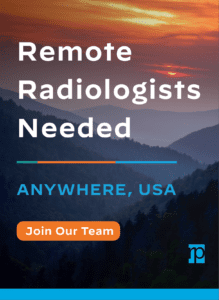Dr. Behringer shares how RP offers technological and staff support, as well as schedule flexibility, that allows her to spend more time focusing on patient care and enjoying work-life balance.
Dr. Jessica Behringer is a neuroradiologist living in Buffalo, N.Y., who reads remotely for hospitals in Florida. Outside of work, she enjoys spending time with her husband and two young children (ages 1 and 3), traveling, trying new restaurants and playing video games. She joined RP in 2023.
We talked to Dr. Behringer about how she connected with RP during residency and ultimately decided to pursue a full-time career in neuroradiology with RP.
Tell us about why you chose radiology. What inspired you to become a radiologist?
Originally, I did not even have radiology on my radar as a third-year medical student. However, I did an elective interventional radiology rotation at a rural hospital in western New York. The rotation was so fun, and the radiologist was a great teacher. His excitement about pathology and anatomy, as well as his passion for caring about each of his patients, inspired me to join the field.
What drew you to neuroradiology?
I found the anatomy and pathology of neuro cases to be challenging and interesting. I wanted to get more experience in that field and have the ability to collaborate with other neuroradiologists on interesting cases. I was once given this advice: choose a fellowship that you find interesting, difficult, or both. Neuroradiology fell into the “both” category for me.
How did you connect with RP?
I originally learned about RP when I was on the interview trail for radiology residency, and I ended up matching with a program at Franciscan Health Olympia Fields, just south of Chicago. That residency program partners with an RP practice. It was a great opportunity for me to be able to experience an RP team while I was still in training and utilize a lot of the tools typically reserved for an attending RP radiologist. After training, those original RP connections helped me to secure my current job.
What excites you about RP? What is most fulfilling about working as a radiologist for RP?
The best part of RP is the people, as corny as it sounds. Even though I am remote, I enjoy collaborating and interacting with my colleagues on a daily basis. It makes the workday much easier when you enjoy the people you interact with. Our support staff helps us bridge the communication gap with technologists and referring clinicians. They are always helpful and friendly. Finally, I can count on my practice directors to promptly answer my concerns and offer flexibility when the need arises. I have two young kids, and I am grateful for the flexibility and support offered by my local practice. With so many radiologists in different subspecialties at my local practice, I’m able to focus on neuroradiology, and if needed, I have a lot of support to back me up.
What are some of the unique features that RP offers that are hard to find elsewhere?
RP provides great support to the radiologist. I can spend much more of my time focusing on patient care and doing a quality job evaluating cases because RP staff is working in the background to help connect me to referring clinicians or following up on incomplete studies. This provides a lot more time for the radiologist to focus on image interpretation.
How has your opinion of RP changed before joining the practice versus being a radiologist at RP?
Since I had the unique position of training with an RP practice, my opinion of RP has always been positive. I have also learned that each RP team is unique after experiencing multiple practices during my training and in my job search.
How has the field of radiology evolved since you first started your career and what does the future of radiology look like to you? How will RP contribute to that?
I’ve only been in practice for two years; however, since I started training, radiology has already changed in many ways. For instance, volumes are steadily increasing, which means radiologists spend less time per study than ever before. Another change to help combat this is the use of AI in radiology imaging and reporting. Since I’ve started at my current RP practice, we have been using AI to help identify brain bleeds, large cerebral vessel occlusions, cervical spine fractures, pulmonary emboli and rib fractures. We have also implemented AI tools that assist the radiologist by creating impressions or recommending the best follow-up for incidental findings. All of these tools are to help the radiologist in their workflow and identify the critical findings. I think RP is ahead of the curve in terms of radiologist utilization of AI.
Dr. Jessica Behringer earned her medical degree from Lake Erie College of Osteopathic Medicine in Greensburg, Pennsylvania; completed her residency at Franciscan Health Olympia Fields in Olympia Fields, Illinois; and completed her fellowship in neuroradiology at Yale New Haven Hospital in New Haven, Connecticut.
Radiology Partners, through its owned and affiliated practices, is a leading physician-led and physician-owned radiology practice in the U.S. Learn more about our mission, values and practice principles at RadPartners.com. For the latest news from RP, follow along on our blog and on X, LinkedIn, Instagram and YouTube. Interested in learning about career opportunities? Visit our careers page.






